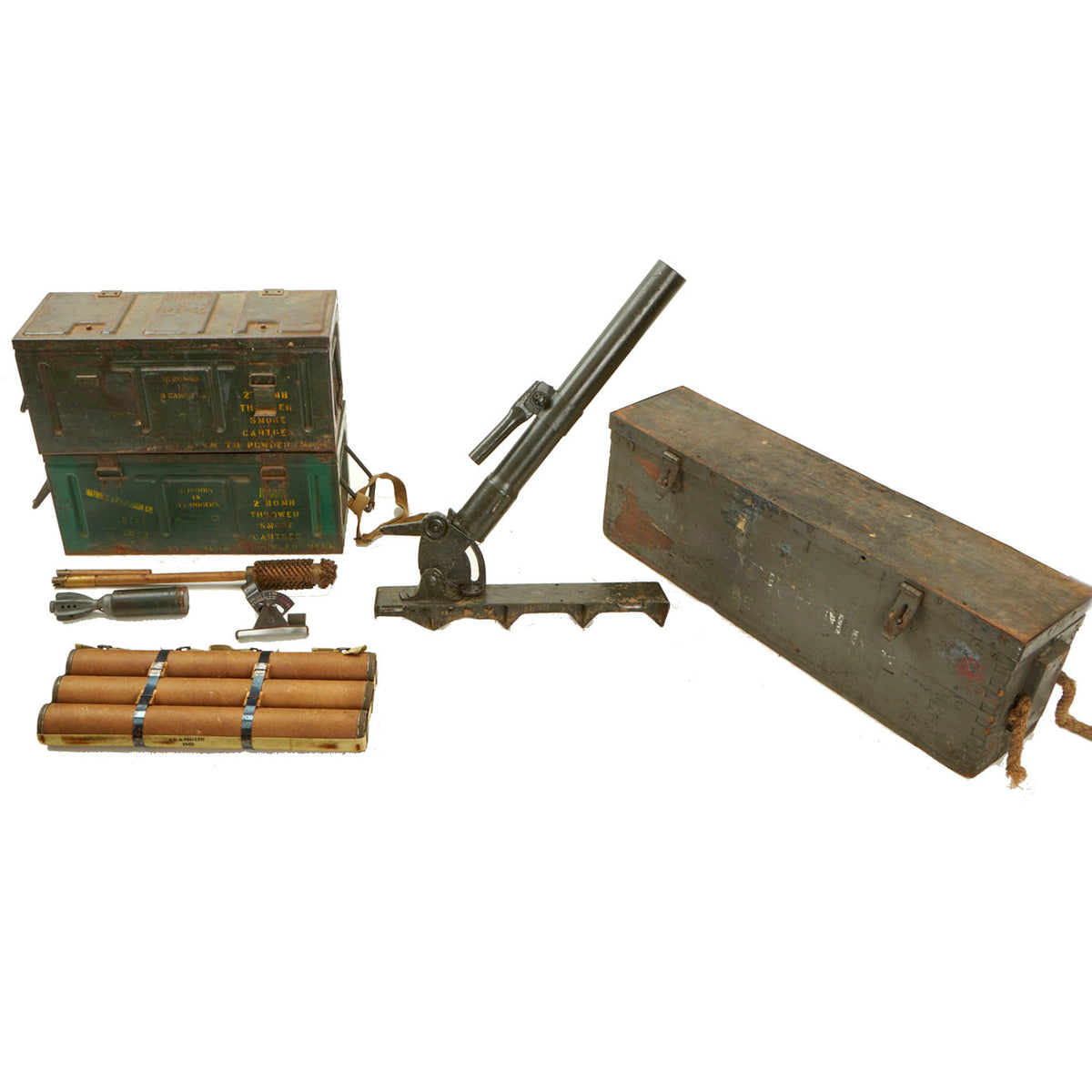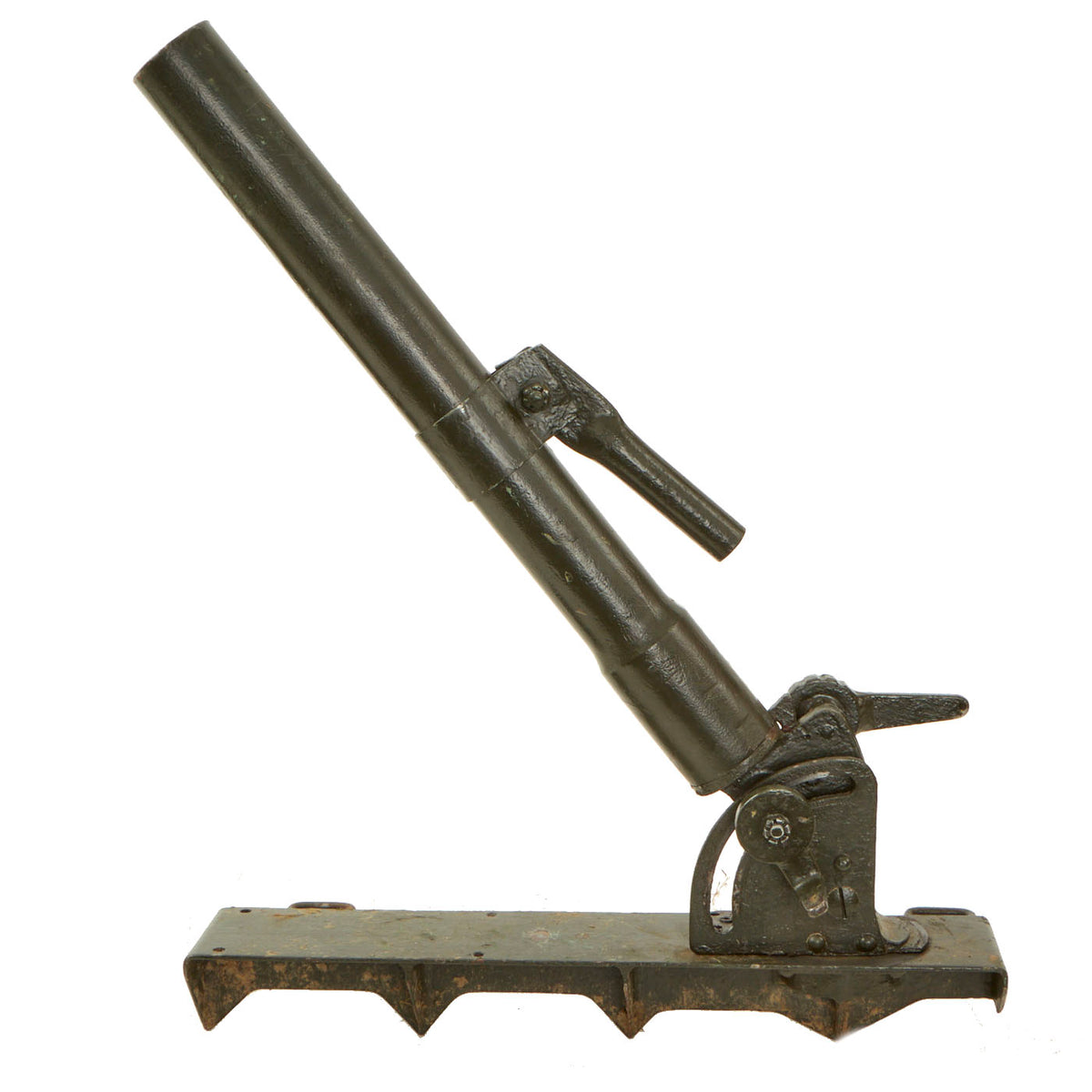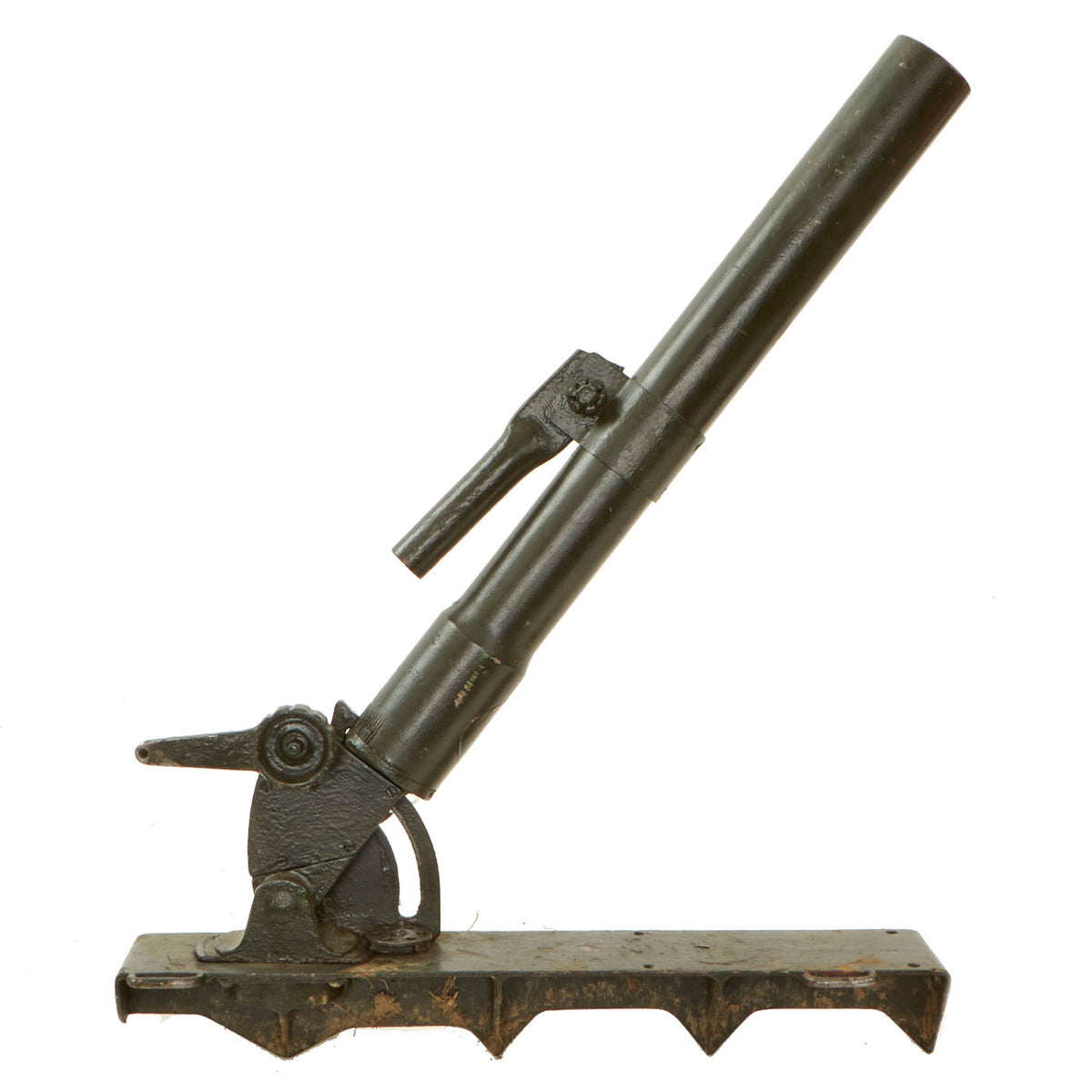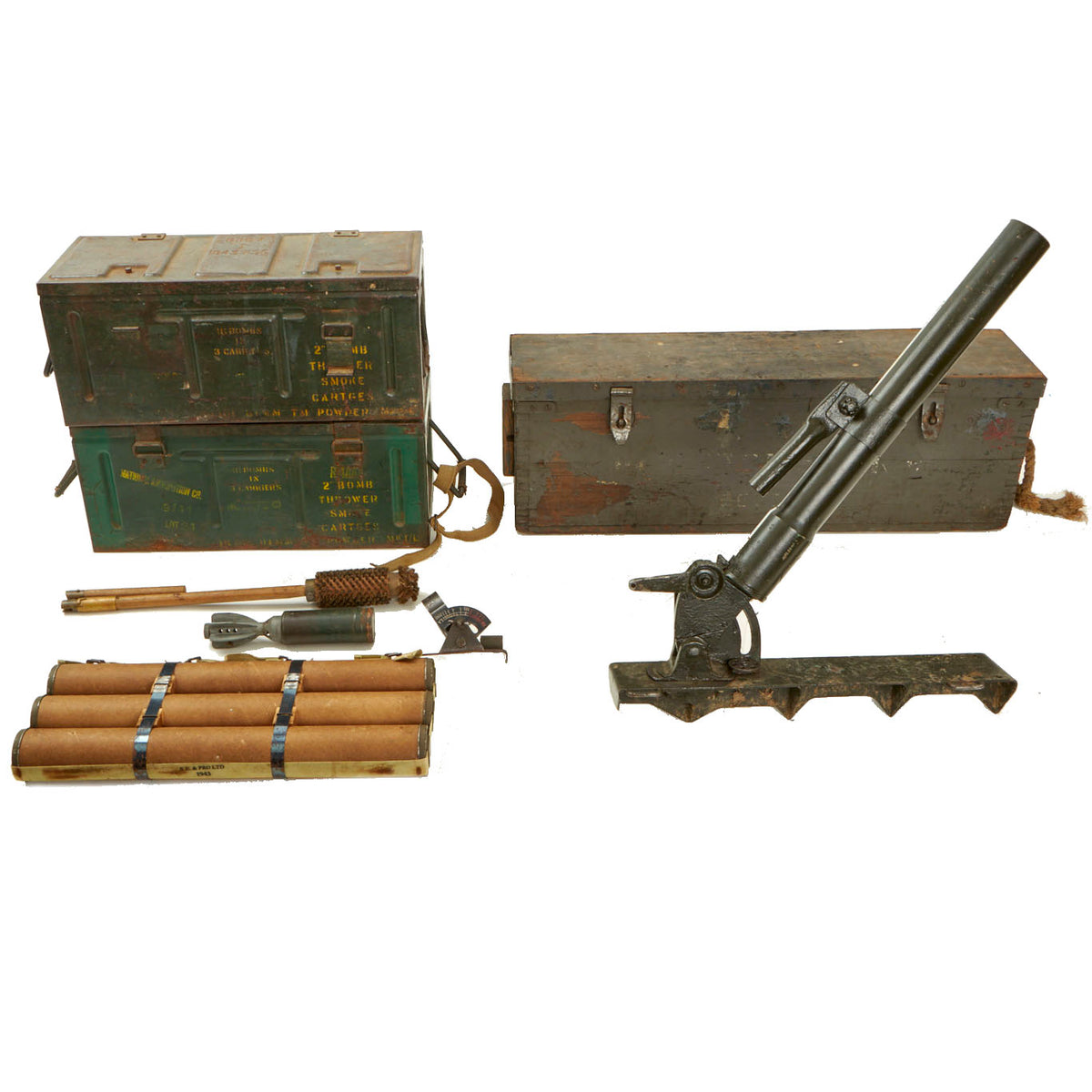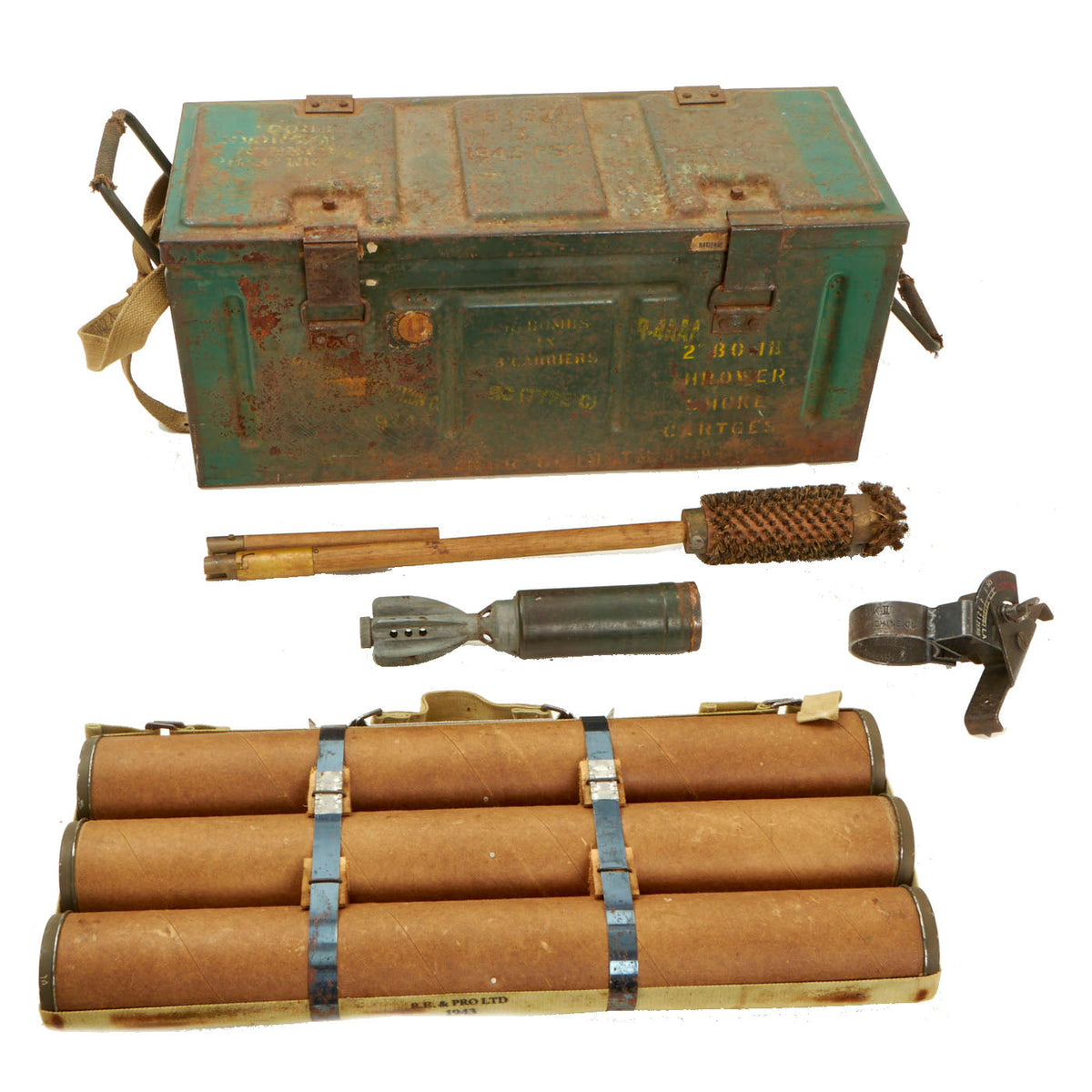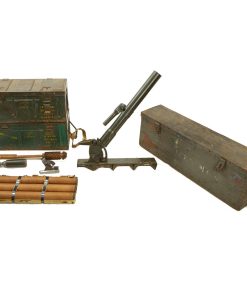Original British WWII SBML Two-Inch Mortar MKII Set with Transit Chest, Sight, Inert Bomb, Ammunition Chests, Gunner’s Valise, and More Original Items
$ 3.295,00 $ 823,75
Original Items: Only Ones Available. An outstanding WWII British Mark II 2-Inch Mortar with a plethora of Original wartime accessories! This is the first 2-Inch Mortar of this particular type we have had the pleasure of offering!
The Mortar, and the accompanying Mortar Shell are demilitarized to BATF (Bureau of Alcohol, Tobacco, Firearms and Explosives) specifications, are totally inert and legal to own without Federal License.
The Set comes with the following:
– MKII Two-Inch Mortar. The Mortar appears to have been repainted several times over the years. Elevation and Traverse work properly. Firing mechanism functions. Some markings and numbers are visible at the breach, but we are unable to discern a date or maker’s markings. Comes with a spare elevation locking nut.
– Clamp-On Bubble Sight. Marked with Broadarrow and “SGT. 2 IN. MR. NO.3 MKII/BUFFWELL ENGINEERING & MACHINE CO.” The condition is good with a fair amount of original bluing, and white/red paint in the sighting tangent. Both glass leveling bubbles are intact and work. There is some corrosion evident on the sight.
– Inert Two-Inch Parachute Illumination Round, dated February, 1943. Body is Broadarrow stamped. Aluminum fin assembly exhibits proof and inspection stamps. Transit cap on the fin assembly is intact and dated 1941. This is an excellent condition example of a rare round, with intact stenciled markings and original paint.
– Two Mortar Bomb Ammunition Chests. Both Dated 1943. Both retain their original paint, with stenciled markings in yellow. Original paper labels are still affixed to either box as well. Both boxes were intended to carry eighteen mortar bombs in cardboard tubes.
– Two-Inch Mortar Bore Cleaning Brush
– British Military Hammer. Marked “M179H” on the head.
– Three Two-Inch Mortar Lifting Charges which fit in the fin assembly. Two made by Kynoch of England, and one
by Dominion of Canada.
– Four Bakelite Transit Caps for Two-Inch Mortar Rounds. Each marked “2” MOR”.
– Canvas Gunner’s Web Canvas Valise. Empty without contents.
– Canvas Web Strap
– Museum-Grade Replica of one of the Mortar Bomb Packing Tube Assemblies. Often seen carried out of the boxes by British Tommies in WWII, this is a highly accurate representation of one of the “Battle Pack” Cardboard/Canvas packaging assemblies which were intended to be removed and carried by the mortarmen. Each set carried Six Mortar Bombs. The whole assembly filled one of the three internal “racks” inside the steel ammunition chest.
This is an excellent opportunity to obtain a rather elusive WWII British/Commonwealth piece of ordnance which is often missing from even the most extensive collections of WWII militaria!
The Ordnance SBML two-inch mortar, or more commonly, just “two-inch mortar”, was a British mortar issued to the British Army and the Commonwealth armies that saw use during the Second World War and later.
It was more portable than larger mortars, and had greater range and firepower than rifle grenades. Its main purpose was to produce smoke for cover and -through high trajectory and HE shell – engage targets “immune to small arms fire
The two-inch mortar was one of a number of small mortars brought into service by European nations between the two World Wars.
Due to its small size, and for simplicity, the mortar had no forward strut or bipod like larger designs needed. The barrel was held at the correct angle by one soldier while the other loaded and fired the round. The original design had a large base plate and sights for aiming which used spirit levels. As the design matured, the baseplate became smaller and the sights were omitted. Aiming was by eye and relied on the firer’s judgment and experience. With such a short barrel the normal firing method, where the bomb was dropped down the tube and a pin in the base of the barrel struck the detonator in the tail of the bomb, would not work, so firing was by a small trigger mechanism at the breech.
The bombs were cylindrical with a (perforated) four finned tail. For the HE projectile an impact fuze was fitted in the nose of the bomb.
Post war, the two-inch mortar was kept in service to fire smoke and illuminating rounds. It was replaced by the Royal Ordnance 51 mm infantry mortar in the late 1980s.
Specifications
- Calibre: 2 inches (50.8 mm)
- Length: 21 inches (53 cm)
- Weight: 10 + / – 1⁄2 pounds (4.8 kg)
- Firing mechanism: Trip (small trigger)
- Elevation: 45-90°
- Range: 500 yards (460 m)
- Rate of fire: Eight rounds per minute
Fast Shipping with Professional Packaging
Thanks to our longstanding association with UPS FedEx DHL, and other major international carriers, we are able to provide a range of shipping options. Our warehouse staff is expertly trained and will wrap your products according to our exact and precise specifications. Prior to shipping, your goods will be thoroughly examined and securely secured. We ship to thousands clients each day across multiple countries. This shows how we're dedicated to be the largest retailer on the internet. Warehouses and distribution centres can be located throughout Europe as well as the USA.
Note: Orders with more than one item will be assigned a processing date depending on the item.
Before shipping before shipping, we'll conduct a thorough inspection of the items you have ordered. Today, the majority of orders will be delivered within 48 hours. The delivery time will be between 3-7 days.
Returns
The stock is dynamic and we cannot completely manage it because multiple stakeholders are involved, including our factory and warehouse. So the actual stock may alter at any time. It's possible that you may not receive your order once the order has been made.
Our policy is valid for a period of 30 days. If you don't receive the product within 30 days, we are not able to issue a refund or an exchange.
You can only return an item if it is unused and in the same state as the day you received it. You must have the item in its original packaging.
Related products
Uncategorized
Uncategorized
Uncategorized
Uncategorized
Uncategorized
Armoured Fighting Vehicles of the World: AFVs of World War One (Hardcover Book) New Made Items
Uncategorized
Uncategorized
Uncategorized
Uncategorized
Uncategorized
Uncategorized
Uncategorized
Uncategorized
Uncategorized
Uncategorized
Uncategorized
Uncategorized
Uncategorized
Band of Brothers ORIGINAL GERMAN WWII Le. F.H. 18 10.5cm ARTILLERY PIECE Original Items
